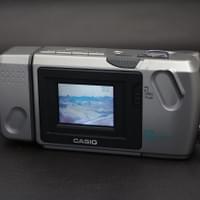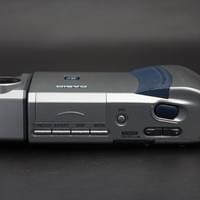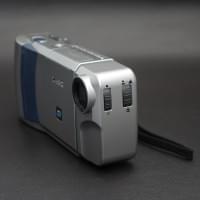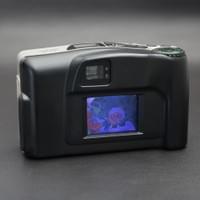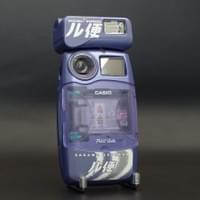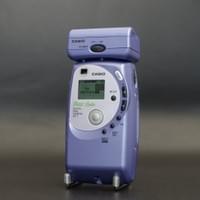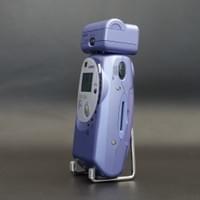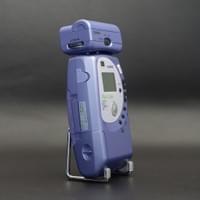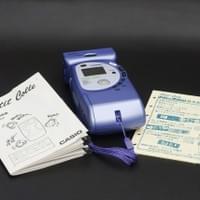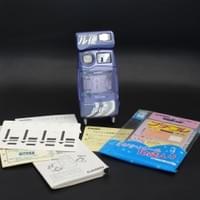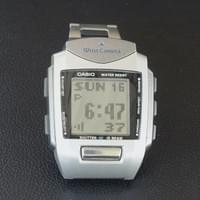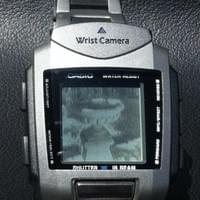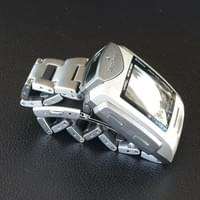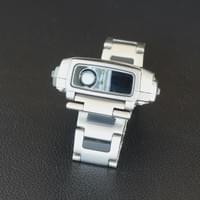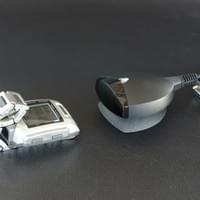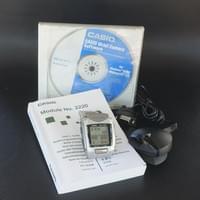
Casio QV-10 (1995)
Here is one of the most celebrated cameras of the early digital era. But why was something so simple so special? Why is this model included in every list of the most significant digital cameras of all time (such as in Popular Photography)?
To understand why, it helps to remember that the QV-10 came out in 1995. Up till then, digital cameras comprised either super expensive SLR-style systems or binocular-shaped cameras – see the home page of this website. Neither type had an integrated screen for viewing photos. Suddenly, Casio marketed this simple and affordable camera with a liquid crystal display (LCD) on which you could compose your photos and review them. It was priced at a fair US$800.
The camera was a sensation and a hot seller.
Casio was clearly excited about its screen, so it explained right there on the box that the technology was thin film transistor (TFT) liquid crystal.
Inside the camera there was a 0.25 megapixel sensor and 2mb of storage for your photos. On the outside there was a swivel lens, a macro switch and a curious "light-dark control" switch for altering the lens aperture, although no flash. My example shown here is the CIA variant. Casio marketed several variants of the QV-10, each with slight technical differences. My example also has an extremely rare set of snap-on conversion lenses (0.7 wide angle and x2 telephoto) that were specially made for the QV-10 as an optional extra. The set is designated LU-10.
The photos produced by the camera weren’t of great quality. But what really mattered was that the QV-10 gave early adopters of technology the opportunity to leap several years into the future.
Casio QV-200 (1997)
Casio brought out 20 digital cameras from 1994 to the end of the 1990s, all but two of them with the designation "QV". So customers might have been struggling to know which camera was which. Moreover, almost all of them had a swivel lens, so that particular feature wasn't distinguished in the nomenclature.
This 1997 model is the 200. It closely resembled the original QV-10 from 1995 and the specifications hadn't advanced much. The resolution had grown from 0.25 megapixels to 0.36 megapixels, but the internal storage remained at 2mb and the fastest shutter speed remained at 1/4,000 sec. The little LCD screen remained at 1 1/8". But the photographer could do some basic image manipulation in-camera, including conversion to artificial colours and sepia.
Good news, the price had dropped from around US$800 for the 10 to around US$350 for the 200.
Casio ZR-1 'Petit Colle' (1998)
This device is a cross between a digital camera and a gimmick.
The ZR-1 was sold only in Japan – or given away as a promotion such as this one – from 1998.
It came out with the nick-name ‘Petit Colle’ which literally means “little glue” in French. That's an odd name. Maybe it's a reference to the camera’s small thermal print-outs, sticky seals that are pasted into supplied paper frames. My photos show a selection of seals and frames.
The camera instructions were only ever in Japanese, although much of the writing on the camera is in English, including the information shown in the LCD.
Maybe it's gimmicky, but the ZR-1 is not a toy. It has some useful photographic features – a 0.08 megapixel sensor, an f/2.8 fixed-focus lens and internal memory for two photos. It also has a clip-on flash, self-timer and a viewfinder that doubles as a mirror for framing self portraits.
It’s easy to imagine a pair of Tokyo teenagers snapping a selfie, waiting a few seconds for the camera to spit out the small photo, then pasting it into a frame to make a treasured keep-sake.
The particular camera you see here was a not-for-sale promotion by the large Japanese logistics company Sagawa Express.
Casio Wrist Camera WQV-1 (2000)
I'm so excited to present this Casio to you. It's a departure from everything else on this site and it's a world first.
I was going to describe it as a “wrist watch with a digital camera". Then I noticed that digital camera experts describe it as a “wrist watch digital camera”. On the instruction manual, it's titled "Module No. 2220". However, I’ll go with the name that’s on the device, “Wrist Camera” and it's the first ever produced.
It’s certainly a cross-over product from the early years of both digital photography and digital watches.
It has the things that an early digital watch has – like date/time, stopwatch, countdown timer and big numbers on its liquid crystal display. The WQV-1 can also take 100 b/w photos and store them internally or transmit them via its infrared (IR) facility to a PC or another WQV-1. The wrist camera was sold in a dark grey plastic casing or this flash aluminium casing.
Like many cross-over products, it is a compromise. It’s sensor is very small, at 28,000 pixels and the LCD screen is only 120 x 120 dots. Viewing the stored images is a struggle, as my photo shows.
Set against these limitations, you could use the camera to create a visual contacts list – take a photo of a customer's face and add the contact details on the device. I suspect Casio sold quite a few of these wrist cameras to early adopters who showed it off to amazed friends before quickly discovering its limitations in their daily lives.
David Leith © 2025














